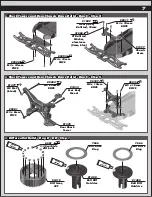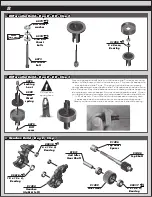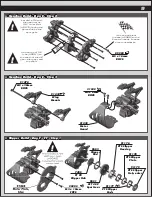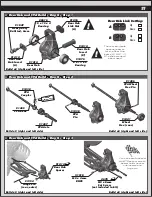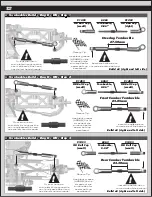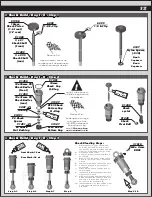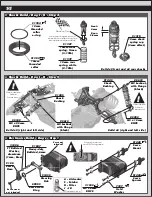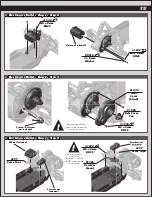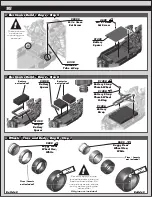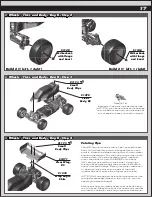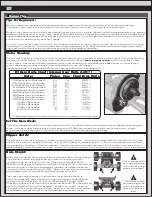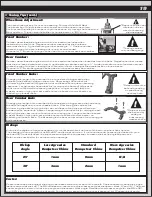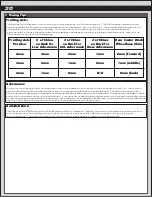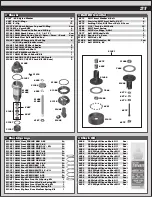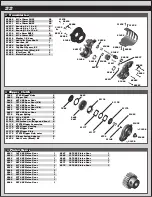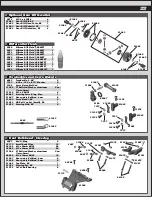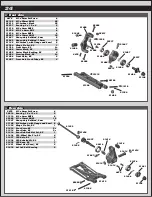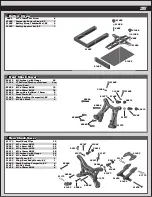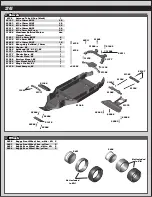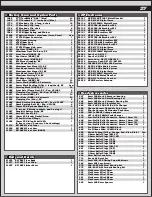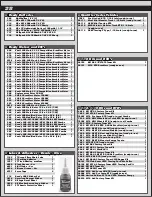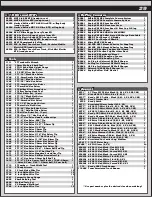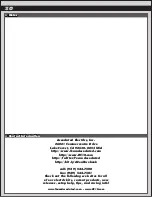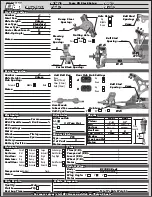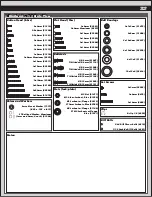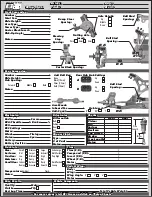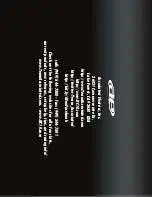
19
:: Tuning Tips (cont.)
Caster:
Caster describes the angle of the kingpin as it leans toward the rear of the vehicle. Positive caster means the kingpin
leans rearward at the top. The B5 includes two inserts to adjust caster angle at the caster block, 0
°
and +5
°
. The total
caster angle is the sum of the kick-up angle and the caster block angle. Standard total caster angle for the B5 is 30
°
,
with 25
°
kick-up and 5
°
caster block angle. For less entry steering and more exit steering, try 0
°
caster block angle.
Rear Camber:
Camber describes the angle at which the tire and wheel rides when looked at from the back. Negative camber means
that the tire leans inward at the top. A good starting camber setting is -1°. Adding a small amount of positive camber,
where the top of the tire is leaning out, will tend to improve straight-line acceleration on loose tracks.
Optional #1719 camber gauge can be used to more accurately set camber.
Front Camber Links:
Changing the length of the camber link is considered a bigger step than
adjusting the ball end height on the tower. Shortening the camber link
(or lowering the ball end) will give the front end less roll and quicken steering
response. Lengthening the camber link (or raising the ball end) will give the
front more roll and slower steering response. Longer camber links are
typically used on high grip tracks and shorter links tend to work better on
medium-grip loose tracks.
*Raise or lower the
ball end by adding
or subtracting
washers here
!
Rear Camber Link:
Changing the length of the camber link is considered a bigger step than adjusting
the ball end height on the rear chassis brace. Shortening the camber link
(or lowering the ball end) will give the rear end less roll and the car will tend to
accelerate or “square up” better. Lengthening the camber link (or raising the ball
end) will give the rear more roll and more cornering grip. Longer camber links are
typically used on high grip tracks, while shorter links tend to work better on
medium grip loose tracks. The kit setting is the best compromise of cornering grip
and acceleration.
*Raise or lower
the ball end by
adding or
subtracting
washers here
!
Wheelbase Adjustment:
You have three options for rear hub spacing, Forward, Middle, & Back.
The kit setting of Middle is the most neutral, and will be used most often.
For improved handling in bumps or rhythm sections, try moving the hubs to the
Back position. This can also make the car handle better in 180° turns.
*Spacers to the rear
will place hubs for-
ward, shortening
the wheelbase
!
Front Camber:
Camber describes the angle at which the tire and wheel rides when
looked at from the front. Negative camber means that the tire leans
inward at the top. A good starting camber setting is -1°. Positive camber,
where the top of the tire is leaning out, is not recommended.
Optional #1719 camber gauge can be used to more accurately set camber.
*Testing camber
with camber gauge
!
Kickup:
Kickup is the angle the front suspension arm mounts at where the front of the arm is higher than the rear.
The standard kickup angle for the B5 is 25
°
, and is most common. If more corner entry steering is desired, try the
included 30
°
front bulkhead. It is important to adjust the bumpsteer to match the kickup angle adjustment.
Refer to the chart below for some common settings:
Kickup
Angle
25°
1mm
0mm
30°
3mm
2mm
1mm
Less Agressive
Bumpsteer Shims
Standard
Bumpsteer Shims
More Agressive
Bumpsteer Shims
N/A
Summary of Contents for rc10b5
Page 1: ......



